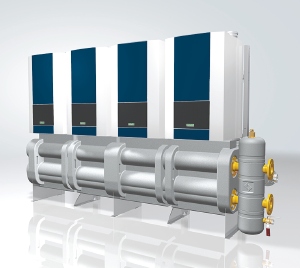Boilers that deliver

Today’s energy-efficient boilers can only deliver their potential in a well designed and controlled systems — says Paul Sands of Stokvis Energy Systems.
The average person’s image of a commercial plant room probably resembles something from the bowels of a wartime battleship, complete with a couple of huge old boilers, festooned with large glass dialled gauges and spouting steam.
The reality in the commercial market these days, of course, is rather different, with about 70% by unit numbers being occupied by wall-hung boilers based on commercial boilers from 30 kW upwards. To what extent these modern condensing boilers actually deliver higher efficiencies compared to their cumbersome old counterparts is, however, dependent on a number of factors — including whether they are correctly sized and specified, as well as the manner in which they are controlled.
So what are the main principles to be respected in the creation of an efficient heating and hot-water system?
Although there is sometimes a definite desire on the part of clients to provide for future flexibility in terms of additional demand, consultants should resist the temptation to oversize boiler plant. Aside from the increased capital outlay, one could be reducing the boiler’s capacity to modulate at low loads. It is also important to design for achieving low return temperatures to maximise the time when a boiler condenses. A Larger ∆T or a return temperature of 56°C or below is generally considered desirable.
Wall-hung boilers are often installed as a cascade of three or more units, which not only means maintenance can be carried out without interruption of service but also allows the duty to be shared among the boilers.
 |
| Modular boiler installations operated in cascade offer opportunities boosting energy efficiency and reliable operation. |
Interestingly most condensing boilers offer slightly better efficiency when running at a percentage of their potential output, which can be taken advantage of in a cascade arrangement. While figures vary between different boiler ranges, a model which delivers 102% net efficiency at 100% capacity might see this rise to 106% net when running at 25% capacity; this increase results from the lower volume of flue gas passing over the heat exchanger.
With an appropriate sequencing controller, one boiler would modulate up until the demand requires output from a second unit — at which point the duty will be shared equally between the pair. The same applies when a third boiler has to contribute. Meanwhile the main controller also ensures ‘first-up’ duty is rotated between the individual boilers in order to even out wear.
Meanwhile with the Stokvis Modupak option, the installer is provided with the connection kit, manifolds, and combined low loss header and dirt/air separators necessary to protect modern heat exchangers.
Weather-compensation of condensing boiler plant directly utilising outside temperature sensors, will provide higher efficiencies and further savings, since a lower flow temperature will also give a lower return temperature and, therefore, aid condensing possibilities.
In practice at part load, the boiler controller reduces the fan speed, in turn causing a pressure drop which is utilised to modulate down the pressure-operated gas valve. By incorporating weather-compensation control, the premixed air and gas is modulated down further.
Introducing weather compensation directly to the boiler plant is one of the key measures that can be used to improve the performance of new and existing heating systems. Another, often equally effective measure, is to replace hot-water storage vessels with modern plate heat exchanger (PHE) technology.
 |
| Using a plate heat exchanger to generate domestic hot water on demand avoids the inefficient operation of boilers to maintain the temperature of stored water in calorifiers. |
When a boiler constantly cycles to try to maintain the temperature of large amounts of stored domestic hot water, it is generally firing inefficiently, normally well below its modulation range. The way to eliminate these cycling and standing losses is to replace the calorifier with a PHE, such as one of the Econoplate packaged plate heat exchangers, that heats domestic water on demand at much higher levels of efficiency and combats the possibility of legionella contamination.
Essentially the PHE set up sees higher loads being met instantaneously, resulting in the boiler mainly working within its part load or modulation capabilities. The plate heat exchanger also provides primary return temperatures as low as 35°C which is ideal for condensing boilers.
Further savings would be achieved by making use of a preheat vessel where the hot water is heated from a solar thermal system.
Given the Government’s green agenda, the proportion of smaller, wall-hung boilers is likely to remain as the larger share of the market as the uptake of renewable energy increases and, therefore, the ‘top -up load’ provided by the boiler plant dictates smaller boilers that can provide good turn down/modulation with condensing capability that match the required load.
Just as aboard naval ships nowadays the stokers’ job has been supplanted by technicians monitoring computer screens, commercial plant rooms have been transformed by modern compact boilers, with these offering low water content and fully modulating performance, coupled with advanced control provisions. It is then up to consultants to work collaboratively with manufacturers to ensure the specification brings the best from the boilers.
Paul Sands is sales and marketing director with Stokvis Energy Systems.







